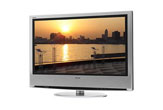How to Shop for a New 3-D HDTV

If you've watched 3-D movies such as "Avatar" or the new "Alice in Wonderland" in theaters and are hankering to recreate that immersive experience at home, you may want to take a closer look at the new 3-D TVs that are beginning to hit store shelves.
Just this week, Samsung's 46" 3-D TV arrived at retailers across the country, the first 3-D high-definition TV available to the public.
Sony 3-D models are also available for preorder now, and Panasonic, LG and Toshiba are scheduled to release their own sets later this year. The TV research firm iSupply forecasts 3D TVs will command a price premium of $600 to $700 compared to 2D LCD-TVs using Light Emitting Diode (LED) backlighting.
Scott Birnbaum, vice president for Samsung LCD business told TechNewsDaily that the secret to choosing a 3-D TV is looking at how the TV displays regular, 2-D content. He urges shoppers to take advantage of the side-by-side arrangement of televisions in stores and ask the salespeople to run some 2-D content as well as 3-D.
"Just have them turn on some 2-D content and see what it looks like," Birnbaum said. "If 2-D doesn't look as good as 3-D, then you know it doesn't have the faster refresh rates. You can actually tell just by looking at the TV content."
Refresh rate refers to the number of new images displayed per second to achieve smooth motion and is measured in hertz. A higher refresh rate is imperative for a realistic 3-D display. Look for "true" 240 Hz technology, Birnbaum said.
Birnbaum said to beware some 3-D televisions that insert black frames to achieve the higher 240 Hz refresh rate, which can result in a jumpy picture, and in some cases, eye fatigue and headaches.
Get the world’s most fascinating discoveries delivered straight to your inbox.
Even though the actual content is only coming in at 60 frames per second, true 240 HZ technology inserts three additional frames of color content, not black frames, to deliver a smooth display.
Other 3-D shopping considerations
As with regular TVs, the bigger a 3-D TV screen is, the more immersive the experience will be. But instead of simply buying the largest TV set the store has, first consider the size of the room where the TV will be housed.
Most people's living rooms are set up so that their couches are about ten feet away from the screen, so a screen size of at least 40 inches will provide an immersive 3-D experience, Birnbaum said. Shoppers will find 3-D HDTV ranging in size from 40 inches to 60 inches, as new models are released throughout the year. As a general rule, consider a size up from a 2D TV to minimize peripheral distractions and thereby enhance the 3-D sense of realism. For example, if you're replacing a 40" or 42" flat panel TV in the living room, move up to a 46" 3-D model.
Other accessories
Also, don't forget to purchase new HDMI 1.4A cables, released this week by HDMI Licensing. These new cables allow 3-D TVs and other devices such as cable boxes and Blu-ray players to speak a common 3-D language when transmitting and receiving 3-D content.
Finally, viewers won't get the intended 3-D experience without 3-D glasses, which are sold separately and are often associated with particular models of 3-D TVs.
Birnbaum said he thinks that 3-D TVs will be a big hit with consumers. "Like the introduction of color TVs in the 1960's, 3-D TVs will be exciting enough to bring families and friends together," he said.
Recent surveys also support Birnbaum's prediction. According to recent survey by NDP, a research firm specializing in electronics, one-third of consumers are at least "somewhat interested" in purchasing a 3-D TV.
"Manufacturers are counting on 3-D to accelerate the replacement cycle the way [high-definition] did," said Ross Rubin, executive director of industry analysis at NPD.
“Early adopters will look past significant price premiums and limited optimized content in the name of bringing home even more of the cinematic experience as they find 3-D capabilities included among other premium features.”



